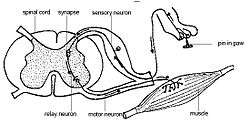Interneuron
| Interneuron | |
|---|---|
 A spinal interneuron (relay neuron) forms part of a reflex arc | |
| Details | |
| Location | Nervous system |
| Identifiers | |
| MeSH | A08.663.358 |
| Code | TH H2.00.06.1.00058 |
| NeuroLex ID | Intrinsic neuron role |
An interneuron (also called relay neuron, association neuron, connector neuron, intermediate neuron or local circuit neuron) is one of the three classifications of neurons found in the human body. Interneurons create neural circuits, enabling communication between sensory or motor neurons and the central nervous system (CNS). They have been found to function in reflexes, neuronal oscillations,[1] and neurogenesis in the adult mammalian brain. Interneurons can be further broken down into two groups: local interneurons, and relay interneurons.[2] Local interneurons have short axons and form circuits with nearby neurons to analyze small pieces of information.[3] Relay interneurons have long axons and connect circuits of neurons in one region of the brain with those in other regions.[3] The interaction between interneurons allow the brain to perform complex functions such as learning, and decision-making.
Interneurons in the Central Nervous System
Unlike the peripheral nervous system (PNS), the central nervous system, including the brain, contains many interneurons. In the neocortex (making up about 80% of the human brain), approximately 20-30% of neurons are interneurons.[4] Interneurons in the CNS are primarily inhibitory, and use the neurotransmitter GABA or glycine. However, excitatory interneurons using glutamate in the CNS also exist, as do interneurons releasing neuromodulators like acetylcholine.
In 2008, a nomenclature for the features of GABAergic cortical interneurons was proposed, called Petilla terminology.[5]
Interneurons of the spinal cord
- 1a Inhibitory Neuron: Found in Lamina VII. Responsible for inhibiting antagonist motor neuron. 1a spindle afferents activate 1a inhibitory neuron.
- 1b Inhibitory Neuron: Found in Lamina V, VI, VII. afferent or Golgi tendon organ activates it.
Interneurons of the cortex
- Parvalbumin-expressing interneurons
- CCK-expressing interneurons
- VIP-expressing interneurons
- SOM-expressing interneurons
Interneurons of the cerebellum
- Molecular layer (basket cells, stellate cells)
- Golgi cells
- Granule cells
- Lugaro cells
- Unipolar brush cells
Interneurons of the striatum
- Parvalbumin-expressing interneurons[6]
- Cholinergic interneurons[7][8]
- Tyrosine hydroxylase-expressing interneurons[9]
- Calretinin-expressing interneurons[10]
- Nitric oxide synthase-expressing interneurons[10]
References
- ↑ Whittington, M.A; Traub, R.D; Kopell, N; Ermentrout, B; Buhl, E.H (2000). "Inhibition-based rhythms: Experimental and mathematical observations on network dynamics". International Journal of Psychophysiology. 38 (3): 315–36. doi:10.1016/S0167-8760(00)00173-2. PMID 11102670.
- ↑ Carlson, Neil R. (2013). Physiology of Behavior (11th ed.). Pearson Higher Education. p. 28. ISBN 978-0-205-23939-9.
- 1 2 Kandel, Eric; Schwartz, James; Jessell, Thomas, eds. (2000). Principles of Neural Science (4th ed.). New York City, New York: McGraw Hill Companies. p. 25. ISBN 978-0-8385-7701-1.
- ↑ Markram, Henry, et al. "Interneurons of the neocortical inhibitory system." Nature Reviews Neuroscience 5.10 (2004): 793-807.
- ↑ Ascoli, Giorgio A.; Alonso-Nanclares, Lidia; Anderson, Stewart A.; Barrionuevo, German; Benavides-Piccione, Ruth; Burkhalter, Andreas; Buzsáki, György; Cauli, Bruno; Defelipe, Javier; Fairén, Alfonso; Feldmeyer, Dirk; Fishell, Gord; Fregnac, Yves; Freund, Tamas F.; Gardner, Daniel; Gardner, Esther P.; Goldberg, Jesse H.; Helmstaedter, Moritz; Hestrin, Shaul; Karube, Fuyuki; Kisvárday, Zoltán F.; Lambolez, Bertrand; Lewis, David A.; Marin, Oscar; Markram, Henry; Muñoz, Alberto; Packer, Adam; Petersen, Carl C. H.; Rockland, Kathleen S.; et al. (2008). "Petilla terminology: Nomenclature of features of GABAergic interneurons of the cerebral cortex". Nature Reviews Neuroscience. 9 (7): 557–68. doi:10.1038/nrn2402. PMC 2868386
 . PMID 18568015.
. PMID 18568015. - ↑ Tepper, James M.; Koós, Tibor (1999). "Inhibitory control of neostriatal projection neurons by GABAergic interneurons". Nature Neuroscience. 2 (5): 467–72. doi:10.1038/8138. PMID 10321252.
- ↑ Zhou, Fu-Ming; Wilson, Charles J.; Dani, John A. (2002). "Cholinergic interneuron characteristics and nicotinic properties in the striatum". Journal of Neurobiology. 53 (4): 590–605. doi:10.1002/neu.10150. PMID 12436423.
- ↑ English, Daniel F; Ibanez-Sandoval, Osvaldo; Stark, Eran; Tecuapetla, Fatuel; Buzsáki, György; Deisseroth, Karl; Tepper, James M; Koos, Tibor (2011). "GABAergic circuits mediate the reinforcement-related signals of striatal cholinergic interneurons". Nature Neuroscience. 15 (1): 123–30. doi:10.1038/nn.2984. PMC 3245803
 . PMID 22158514.
. PMID 22158514. - ↑ Ibanez-Sandoval, O.; Tecuapetla, F.; Unal, B.; Shah, F.; Koos, T.; Tepper, J. M. (2010). "Electrophysiological and Morphological Characteristics and Synaptic Connectivity of Tyrosine Hydroxylase-Expressing Neurons in Adult Mouse Striatum". Journal of Neuroscience. 30 (20): 6999–7016. doi:10.1523/JNEUROSCI.5996-09.2010. PMID 20484642.
- 1 2 Ibáñez-Sandoval, Osvaldo; Koós, Tibor; Tecuapetla, Fatuel; Tepper, James M. (2010). "Heterogeneity and Diversity of Striatal GABAergic Interneurons". Frontiers in Neuroanatomy. 4: 150. doi:10.3389/fnana.2010.00150. PMID 21228905.